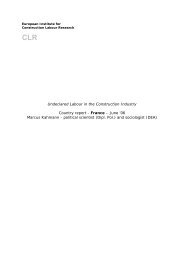Japan – what can we learn? - Construction Labour Research
Japan – what can we learn? - Construction Labour Research
Japan – what can we learn? - Construction Labour Research
Create successful ePaper yourself
Turn your PDF publications into a flip-book with our unique Google optimized e-Paper software.
3.2 Investment sheetSecondary, the proportion of private to public investment is 6 to 4.This places relatively more emphasis on civil-engineeringconstruction as mentioned above. There has been a political debateabout the adequacy of existing economic policy dependent on largerpublic investment. The issues are wide-ranging from who bears thecost, to <strong>what</strong> the decision-making process should be and how to carryout actual construction. The debate spreads out with the historicalindustrial organization of general-subcontracting relationship. Let uslook at private and public investment more closely (See also Figure 2).• Constitution of private investmentThe largest part of the whole investment is private housinginvestment. The composition of private investment is housing(34.8%), non-residential building (18.4%), and engineering (9.6%).Non-residential building consists of commercial office building andindustrial construction such as factories. This commercial andindustrial initiative investment, which was suppressed after the bubbleburst, regained rene<strong>we</strong>d funds around 2004. Ho<strong>we</strong>ver, privateengineering, the central part of which is related to this construction, isrelatively small.• Constitution of public investmentThe core of public investment is public civil engineering thatdominates 32.8% of the whole construction investment. This is thesecond largest part after private housing investment. Public civilengineering plays a substitute role for private engineering in <strong>Japan</strong>.That is, the state or the municipalities undertake the construction ofroads located in industrial facilities, ports and harbours, and so on. Inrecent years, the prominent projects are sewage plants for urbanrenewal programs, waste disposal infrastructure for mass productionand consumption in the industrialized environments, and otherterminal facilities, all of which are constructed in the name ofenvironmental sustainability. Ho<strong>we</strong>ver, the core investment stillremains in the realm for conservation and sustainable projects ofmountains and rivers, agricultural and fishery infrastructure, industrialinfrastructure, and settlement infrastructure (the necessaryinfrastructure for human living, Figure 3).CLR News No 2/200624









